
© Johan Persson. (Click image for larger version)
www.ballet.org.uk
www.tamara-rojo.com
Full details of ENB’s 2015/16 season
“Pay attention to us because …you will enjoy the ride!”
Since 1997 Tamara Rojo has been wowing us in London as one of the most exciting and communicative dancers on the ballet stage. Now known the world over, all the intelligence and commitment she brings to her dance roles is being applied to English National Ballet where she is now well into her third season as artistic director.
While the traditional works, like Swan Lake, are being presented with new levels of polish, she is committed to the new: new ballets, new ways of presenting ballet and finding new ways to fund it. All this means that ENB is an exciting and challenging place under her directorship, if for some an eyebrow or two gets raised at times. You change things and not everybody will be happy or understand necessarily.
My interview with Rojo took place earlier this year and was a wide-ranging affair that looked to fully understand her strategy for the company and I present it here in her words with the lightest of editing to avoid repetitions etc. In detail I think it really conveys the passion and single-minded dedication of the woman to forging a better way forward for the company, and all done while still at the top of her game as a world-class ballerina.
8 June 2015 update: Huge congratulations to all at ENB for winning at the South Bank Show Awards
Celebrating with @BickleJustin & Caroline Thomson #southbankshowawards for #LestWeForget @ENBallet production. pic.twitter.com/24ImuzIRvF
— Tamara Rojo (@TamaraRojo1) June 8, 2015
What we didn’t cover in the time available, was the company initiative, with its school, to finding a new joint home for the first time. Both are currently housed, miles apart, in cramped and very old accommodation that is well adrift of modern standards. Success in their search has recently been announced, so do go and read the press release to get the full picture of an ENB fair galloping into its future.

© ENB. (Click image for larger version)
This is a long page and to make it easier to navigate, here is an index so you have the option of jumping straight to what interests you…
Tamara Rojo – Topics Covered
What is the English National Ballet Brand?
How long to make Rojo’s vision for English National Ballet a reality?
Rojo and New Programming – Second Season with Le Corsaire and Lest we Forget (the first season she was director she inherited existing programming)
Rojo and New Programming – Third Season (this one) – Modern Masters
International Touring and Making Money
UK Touring outside London
(also see Giselle answers)
She Said – the Female Choreographers bill for Spring 2016.
Akram Khan Giselle, the cost of creating work and the Sadler’s Wells relationship
The Creative Process including Giselle
Ballet Remixed – the problem with existing ballets being sacrosanct.
Biggest Lessons that Rojo has learned
Rojo and the World Ballet Festival
How much longer will Rojo dance?
In the following {words in curly brackets} are words spoken by the other person during the flow of an answer or question. Alternatively it also annotates the words – often where we laughed.
What is the English National Ballet Brand?
When I interviewed you last time it was when you were appointed as the new artistic director and the title I put on it was a quote of yours – “I believe I have something to say“. Terrific {we both laugh} So do you think you are saying it?!
I think we are all saying it. In fact it’s interesting that you point out the quote because “We have something to say” is part of the new ENB brand. And I believe that as an organisation we are saying quite a lot of things.
You talk about brand and I remember when the public first saw the new ‘raunchy’ or ‘moody’ publicity poster images many of the traditionalists were rather upset. But what goes beyond that – what is the brand of ENB?
I think the brand of ENB, more than anything, is about creativity and being accessible. In fact it’s a very young company – I mean the members of the company are very young, very hungry, very driven, very approachable. A very tight family unit, that have the skills, the knowledge and respect for the great classics that we do all the time, at the highest standard, *but* then we are also young so that we also want to push those standards and create new things and experiment with new people, whether they are choreographers or designers or fashion designers or photographers.
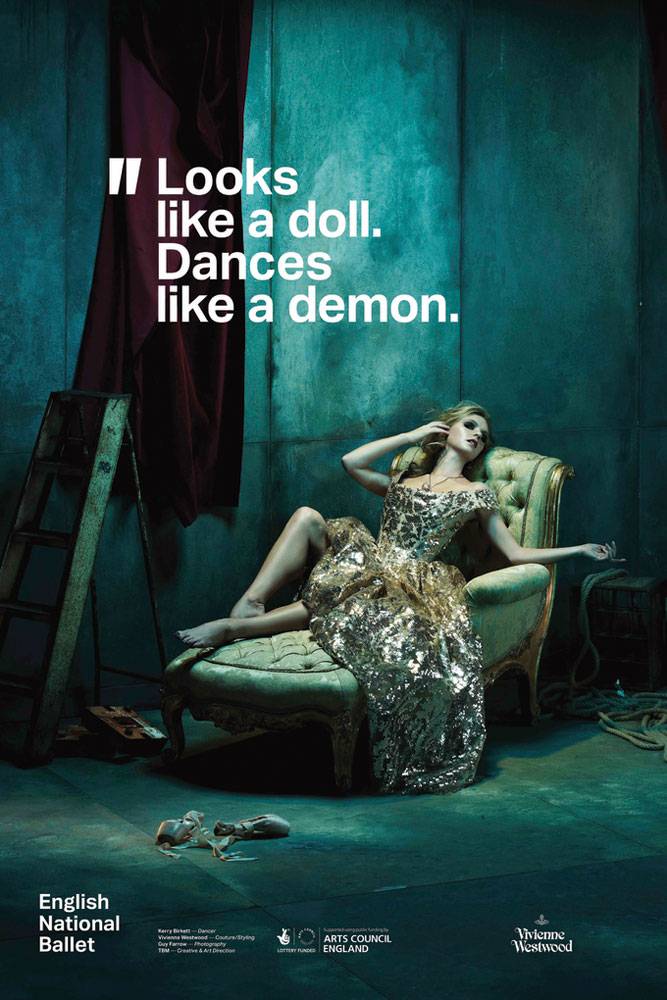
© Guy Farrow/English National Ballet. (Click image for larger version)
So it (those early posters) was a warning almost – “Pay attention to us” because some really good things are going to happen here. And they might not be the thing that you expect from us. But you must trust us because they will be made with the best intentions. And you will enjoy the ride!
How long to make Rojo’s vision for English National Ballet a reality?
The ride is never ever finished or done, but how many years do you need to get the company running as you would wish?
It’s interesting because I was talking to Nick Hytner about this (Hytner recently stood down as artistic director of the National Theatre) and he said that he felt he needed a decade to really achieve his vision. {my goodness} and I can imagine that that’s true. I think that, you know, an organisation needs time to turn. Of course the beauty of English National Ballet is that it’s a small organisation and I think that the turn has happened probably faster than I expected. But to leave an organisation with a solid grounding, with a safety network, with a new repertoire and, to a certain extent, a new range of stars, you do need 10 years probably.
Have you got 10 years?
I’m not sure, we shall see – that’s up to the board.
Rojo and New Programming – Second Season with Le Corsaire and Lest we Forget
(the first season she was director Rojo inherited existing programming)
When you started programming, which was your second season, it was fantastic – we had Le Corsaire and Lest we Forget in one season. And you subsequently won the Critics’ Circle National Dance Award for Outstanding Company. How was it for you, did it sell and did it perform as well behind the scenes as it did for us all out front?
Yes – absolutely. {said with much emphasis} It was one of the most gratifying years of my life. And I think it was the same for many of the dancers that have been here for a long time. To have all this new work. It started with Le Corsaire – a new reworking of a great classical ballet. What happened, which is interesting, is at the beginning we didn’t sell very well because most of the audience don’t really know Le Corsaire. No one in this country had it in the rep. But it was beautiful because it was word of mouth and we ended up at the Coliseum selling out evenings. Because people were saying to their friends “This is extraordinary, you have to see it“. {It got great reviews}. It got great reviews, the audience reacted really well, people wanted to come more than once. So it was fantastic because it was something where you take a chance and you take a risk, and you invest a huge amount of money, for an organisation like ours, but it certainly was worth it.
And then of course in the spring (of 2014) we had these amazing, talented choreographers with us (Akram Khan, Russell Maliphant and Liam Scarlett). And that was again fantastic. For dancers one of the most important things, and one of the things that I don’t feel in my career I’ve been lucky to have that much of, is to create work. And then to create work that you look at and you realise this work is going to last. You know when you are sitting in the audience and you are thinking “I can confidently say that in 10 years’ time people will still want to see this“.
Rojo and New Programming – Third Season (this one) – Modern Masters
After all that success with the new, your next season, the one we are in, seems very different. There have been announcements of things for the future but this season contains nothing new. What Happened?
Well the Modern Masters bill is new – new for us. And that is important – don’t dismiss that, Bruce. That’s incredibly important for an organisation like ours. That three choreographers like John Neumeier, Billy Forsythe and Jiri Kylian are willing to give us their work, is an incredible achievement. Because when I called those people 2½ years ago they were not. So that is incredible for us. It’s incredible for the dancers and the potential choreographers in this company, to be able to work in such different languages. It was only when I worked with Mats Ek that I understood who I was as a dancer. He didn’t necessarily need to create something for me – I needed to understand that language and understand him. I felt “Hold on a minute, this honesty is what I want to put in everything I do – whatever the repertoire is.” And that transformation for the artists, and for the potential choreographers in this company, is very important. So it’s like you say to me that the Royal Academy exhibition of Rembrandt is irrelevant because it’s all old works! Forgive me but I cannot agree. {we laugh}
If I had a budget of £25m a year of course I will be able to produce, maybe, a full length ballet every year. But that’s not what I have. I have what I have and with that I think we are doing a lot. A lot of performances of amazing quality and a lot of introducing repertoire that might not be creations but it’s definitely new, either for the company or for the audience.
International Touring and Making Money
This year is notable as well for there not being anything at the Royal Albert Hall… you seem to be touring the world…
Again, it’s success. It’s as simple as that. This success suddenly means that we are in huge demand internationally and that’s also very important for the reputation of this company and for the reputation of dance in Britain.
I remember the reason why I came here, is because (London) Festival Ballet was touring to Spain. So that was my introduction to the standard of dancing that was happening in the UK. And now it’s my turn to do the same thing because that will translate into great artists wanting to come and be here. And we will go to China, to Singapore to Mexico to Spain. It is also economic – going on international tours makes us money. And dancing here doesn’t.
That’s one of the questions and its quite vital. I’ve never heard any director, other than you, talk about making money from international touring. Every UK director I’ve ever spoken to says they make no money out of touring. It has to be propped up and you need sponsors etc.
They need to look at their own business plan. I know my business plan and I know we make money.
Can I just check what that absolutely means. You have a bank account and the day before you leave it’s at a given amount, you leave, and then when you come back it’s gone up.
Yes. Literally by £100,000’s. By the time we finish this tour of 9 weeks. We will be able to pay for the three creations next year.
And what are you touring?
We are touring everything. We are touring Le Corsaire, Swan Lake, Coppelia and Lest we Forget.
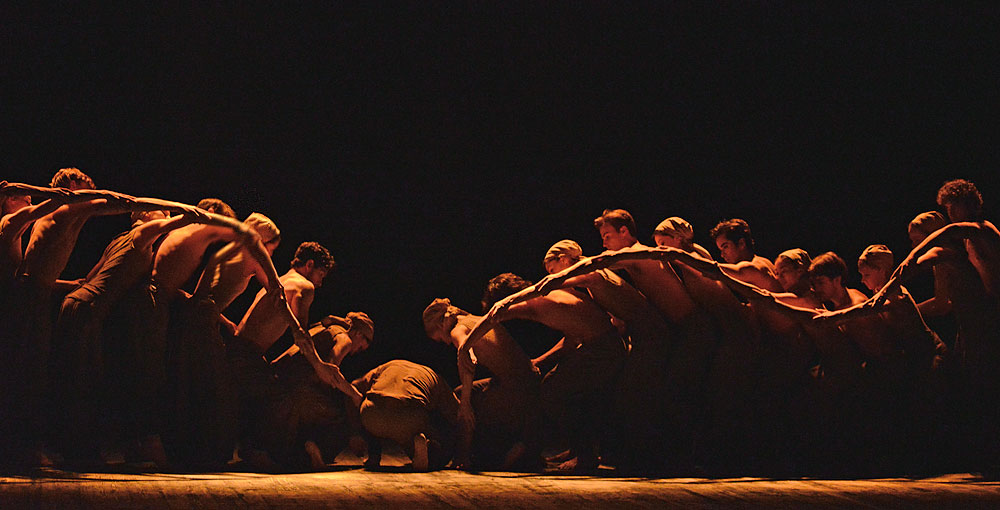
An awful lot of people will want to be talking to your people about how you do that. I hear what you say and I hear it loud and clear. Very loud and very clear. But in a way I still can’t believe that every other director and every other management are so wayward in this respect. But hear what you say.
That’s one of the reasons why I brought in Farooq Chaudhry. Because that’s the model he’s been successfully doing for many years.
Well I understand that model working with a few dancers and no sets but don’t understand it working with 60 dancers…
Akram has huge sets – Desh is enormous. It’s very simple – we have to present these plans to the Arts Council and they’ve been approved by them, so it’s very transparent. There is no mystery to it – just good management.
UK Touring outside London
(also see Giselle answers)
You also mention that touring here makes no money and touring overseas makes money and one of the big concerns I have about ENB is that, forgive my past, but I’ve always seen ENB as a touring company. {We still are} Well, you seem to be the touring company that went to the Arts Council and said we don’t want to tour so much – not in the UK. {Not true}. Well it is {that is not true} It is.
That’s not what we have ever said. It’s not that we are not touring so much, we only reduce one week of our regional tour – that’s the only thing. {1 week out of 6 – a 17% reduction}. Because we have had a 20% cut in our budget – in real terms.
I look at this document – “Arts Council England’s analysis of its investment in large-scale opera and ballet” (document as a pdf) – and which outlines their funding decisions for the next 3 years. And it says there are 3 touring companies, 2 of those touring companies, Northern Ballet and Birmingham Royal Ballet put forward plans to the Arts Council which said we want to tour more and better and they got £550K and £500K extra each. ENB said it wanted to tour less and do more in London and gets nothing. Standstill funding, which is a kind of cut. I think a lot of ENB fans around the country would say, “Well, why didn’t you do what the other touring companies did and fight for UK touring and to bring us good repertoire?”
Because that’s not how it works. Because before you put your plans forward you’ve already had long conversations and you know what the results are probably going to be. So you are realistic when you put your plans forward and we knew that we were not going to get any more funds – regardless of what plan we might put forward. So then we did say we want to tour better – we want to bring to the country the works that we do in London, that are the most creative. They are world winning. So we want to take Lest we Forget on tour, we want to take the new creations on tour. We want to be more creative. That’s what we want to be – otherwise what’s the point of having even more monies if we are all doing the same.
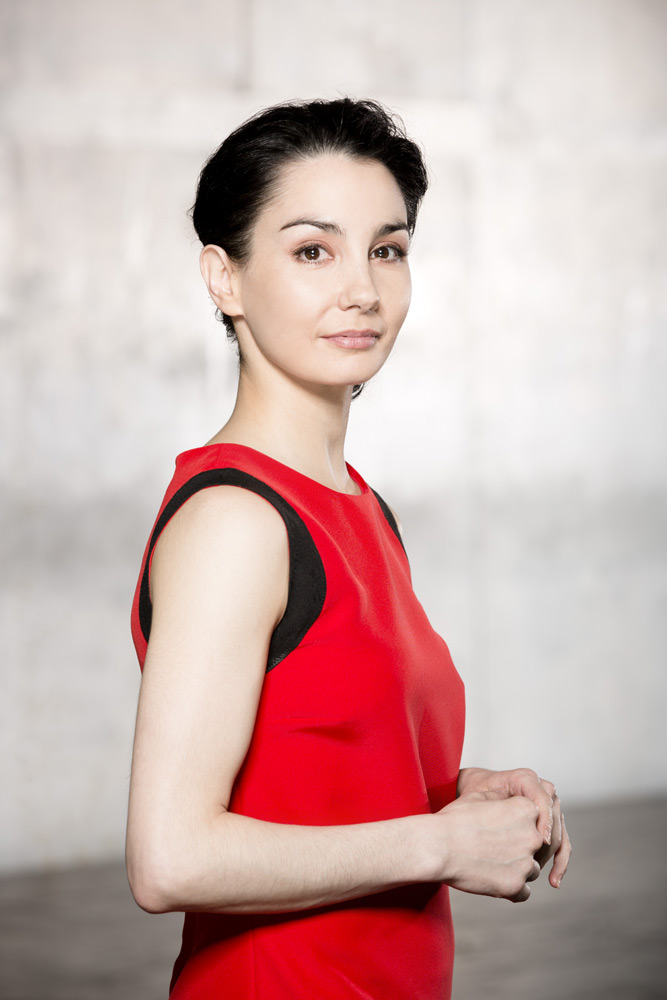
Oh absolutely – that can’t be the case. I remember the first time I saw Swansong, Christopher Bruce’s work, a great ENB commission and I saw the original cast at the 600 seat Wyvern in Swindon. Challenging work. And ENB used to do little mid-scale tours, where choreographers like Christopher Hampson could be grown. ENB seem to have shrunk away from really getting out there, out of London, and mixing it. Instead putting out a message of “Well we can make money overseas, touring in Britain costs too much, we are happy to do 5 weeks in the autumn and then the other 47 weeks are for London and anything else we want to do.” A shrinking of going out to the nation and selling ballet is what some would say.
I totally disagree with you, I have to say. Selling ballet is not just about being physically there – it’s about engaging the audience and making people aware of what you are doing. Being there doesn’t always pay. I understand some people want to see a live Swan Lake, but if you go every year with your big ballet what are you really doing to develop that next audience? What you are doing is shrinking your audience because you are bringing the same thing over and over and eventually people will stop paying attention and will think that ballet is just that one thing.
So my responsibility for English National Ballet is to make it really dynamic, a company that people pay attention to, and I believe we are achieving that. {In London I think that’s certainly the case} I think all over the country – forgive me that’s my opinion. I think everyone is paying attention and the mails we receive are exactly like that. We have to decide how we do that best (make the company dynamic etc) and, like you said, I want to bring those challenging works on tour, but life and times have changed: today no one is really bringing challenging works on tour that much. Because it’s very difficult to sell and bringing something like Lest we Forget is very expensive. But we want to do it (and are) because it’s the right thing to do. We have to make the numbers add up – they are what they are and if we want to bring more challenging and more interesting work, more creative work, then we have to decide where we can do that and how much we can do it.
And that’s what we are doing. We are balancing the numbers, while trying to be creative, while pushing the art form forward and still engaging with the audiences in as many ways as we can. We went to Glastonbury and 50,000 people saw us in one day. So it’s not always necessary to go physically to one place to create an impact. Sometime it’s one event and that we achieve by being creative. By creating something like (Abram Khan’s) Dust – that could be performed at Glastonbury. {Oh yes – don’t get me wrong I was very supportive of that and I was very proud to see it on television as well. It was a wonderful thing.} Exactly. But that doesn’t come without the other, Bruce, you cannot be creative and put £500,000 into something if you don’t have it (the money) because you have to do a mid-scale tour that makes losses. And you keep doing little things and compromising the art form. So you are stuck where you have been for the last 10 years and nothing has changed. And the audiences haven’t grown, in fact they have shrunk and we never fill the theatres and nothing seems to happen. So let’s look at the model and think how can we create a better impact – we create something new, that people pay attention to, that ends up being watched by millions of people because it’s on television. (BBC – ‘Ballet makes Glastonbury debut’
English National Ballet (Glastonbury 2014) HD720p by TheGRStars
Understand. One of the things you said is the idea of doing more in London so you could take more out to the rest of the UK. Do you see it as changing the mix of the 5 weeks or do you ever see it becoming a bit longer? ENB UK touring used to be autumn and then again in the spring.
Yes, but it’s not in our next 2 years plan because the money is fixed. It’s not something that I would completely write out. Again it’s all down to what we can afford to do.
(Full details of ENB’s 2015/16 season including UK touring in October and November 2015.)
She Said – the Female Choreographers bill for Spring 2016.
You’ve created something of a furore about the female choreographers evening – called She Said. Many said “hurrah” and some said “this is no way forward”. Where did the idea spring from and how did it come to be?
Well it sprang from my own experience of working with choreographers and I said it in one of my first interviews with the company. I said that the way that art, that everything, is seen in life, has different angles depending on the people that do it. And that in dance, very often, choreography is created by men, so it has that perspective. And it would be good if we could have it more often created by women. So from the very beginning I wanted to make work where it would be the point of view of women of the art. Doesn’t mean it’s going to be a homogeneous point of view – they are very different people. And already with the production meetings it’s very interesting how different they are in approaching their creations – which is very good! But it’s something that I just simply wanted to do, and I thought it was the right thing to do.
Akram Khan Giselle, the cost of creating work and the Sadler’s Wells relationship
Of course the other big thing which was heralded earlier is the new Akram Khan Giselle – which I think everybody is going “Wow” about for being a very fresh commission. Did I see it was a co-production with Sadler’s Wells and how does that work? And what do you get from the Wells over and above theatre space?
Money. They are investors in the new creations. So that’s very important, because as you know, creation is always the biggest risk. It’s a huge chunk of new budget that has to go towards making a full-length ballet – we are talking around £1M. That’s what a full length ballet costs to make. {yes, yes – can believe it.} And a mixed bill £500,000. So an organisation like ours can’t really take those risks that often, you know. Like I said before, I wish this year I could have done another full-length, but you can’t, because you cant afford to do that. So a way forward to try to do that work is to have partners. So for Giselle we have 3 partners – the Manchester International Festival (MIF), Sadler’s Wells and ourselves. You will be very pleased to know that we will open outside London – not something that many people do.
I was going to ask where does it open? Thank you. {we both laugh a lot, given the earlier exchanges} Fantastic news – I feel very happy about that.
Me too. Because I do have a commitment to our touring tradition. But touring cannot just be taking the same things around the country. Do a world premiere – then they will come. Bring something like Lest we Forget, then at least a new group of people will come.
The Manchester Palace or the Salford Lowry?
We don’t know yet – we are working with MIF to see which.
And will it tour to your normal venues?
Yes – it will come to London, to Sadler’s Wells and it will tour around the country

© Dave Morgan. (Click image for larger version)
In that respect it’s like Le Corsaire or Swan Lake
Exactly. But a really different language and completely different approach.
Can I ask what Sadler’s get out of it?
Well, English National Ballet. How often do you get a new Giselle by Akram Khan? Why wouldn’t they want to be part of that? They are trying to be, they are in fact the theatre of dance in London {Yes – very clear} So I think Alistair (Spalding ) will die if I did this anywhere else in London and not in Sadler’s Wells – don’t you think! {much laughing}
So he puts money in and you perform it at Sadler’s Wells
Yes – we have 2 seasons in Sadler’s Wells – we will have a spring season and an autumn season. In the autumn this year it’s Lest we Forget, She Says next spring, and and then the following autumn it’s Giselle.
When will Giselle premiere? And can anything be said on about designers and things?
No – not yet. We are still waiting for a little bit of funding. I mean we know (the designers) – but we can’t say.
The Creative Process including Giselle
In a creative sense how is Akram Khan’s Giselle going
We had the first extremely exciting production meeting recently. I have to say that’s one of my favourite parts of the job. Just sitting and listening to these incredible artists put all their ideas into a pot and the word “No” is not allowed. So that’s the law in our production meeting. If you don’t think that’s the right thing, you have to bring your own solution. So it’s a creative process. It’s fantastic because you just sit there listening to all these amazing brains – whether they are from the perspective of music, from design, from lighting, from narrative, the choreographer, the producer, everyone putting everything in – for the best of the show.

I’m not a director that commissions someone and then lets them get on with it, and then I come to the opening night. It’s just not what I do. You don’t just wait for the opening night you have to steer sometimes the production in the right direction. You have to give also a perspective that is not emotional, that is not “this is my baby – so I can’t see it other than beautiful”.
Would you jump in if, say, half of a new work was done and it just didn’t seem to be jelling for you?
I did. I mean we had a week of stage calls at the Barbican (for Lest we Forget) – 2 weeks prior to the opening night and I said my views to the choreographers. Then it’s up to them! They don’t necessarily have to do what I say. They have to do their best and whatever they think is best. But it is my responsibility as artistic director to tell them what I think.
Did any changes happen in that case?
Yes. Some did, some not.
It seems right to me – that directors speak their mind, offer gudience…
I know the organisation, I know the audience, I know the dancers. And as I say, it’s not personal in that I haven’t created it myself. So that’s very important – that choreographers get someone outside to give feedback.
Ballet Remixed – the problem with existing ballets being sacrosanct.
(this followed on from the above conversation}
I know this will be controversial, but I think all choreography in general is too sacrosanct. I think when you talk about music, for example, you see in pop music, everyone and anyone can do a version of the Beatles. Sample the Beatles, take bits of it and then wrap it up and mix it up and da da da da da… And nobody considers that disrespectful. However if one of my young choreographers, for their choreographic workshop, decided to take a bit of Jiri Kylian movement – say from Petite Mort – and breaks it down and mixes it up, he would get murdered! And I think this is something that we really need to think about. Because I don’t think it’s in the best interest of dance as an art form – to freeze ballets in time. And you see it with choreographers like Bejart and Roland Petit. The movement language is still good, but because they are frozen in time in every aspect: lighting, costume, sets, everything – even the gestures that you do, you have to replicate whatever someone did 50 years ago. What we really in fact are doing is killing ballet.

I do love going somewhere like the National Theatre where they take plays and they do exactly that mixing up. Because if not, what is an artistic director?
Theatre is much more vibrant as an art form, I think
That’s only because we don’t allow ourselves to be vibrant.
And also because it’s much more vibrant the audience is taken along with it and expects change and new views
Exactly – nobody would expect to see an Arthur Miller play today like they did it in the 40’s and 50s. It would be strange. Writers of the 20th century are not seen as sacrosanct. They mix them up as much as they want, they take them out of context, they put it in a different period of time. They put it on a different planet if they want. I mean I just went to see “Man and Superman” at the National Theatre – it’s a play that lasts almost 5 hours originally. No-one will go and see that. But it’s fabulous now. So is the play worse off because somebody took it down to 3.5 hours? No – it’s better off because new audiences have now gone to see it.
There was an interesting discussion recently, kicked off by a Judith Mackrell blog about the whole thing of do choreographers need editors. It sparked off a live debate at Rambert. It all rather concluded that no they don’t need editors, they needed to be treated carefully and supported. And somebody from theatre stood up and said something like “I really don’t understand you lot. In theatre we all contribute to making the show better and nobody is precious.”
Yes – I totally agree with that point of view. And maybe you want that the first time you create a piece. If the choreographer, you know, is very senior and has very clear ideas, fair enough, you know, who is going to say to Billy Forsythe, “Please don’t do this, or don’t do that”! But 20 years later, why not take In the Middle, Somewhat Elevated and do something different with it? {yes} Why not – that’s my question? And it’s not that it’s going to be better, necessarily, just different. And in 50 years’ time and in 100 years’ time if we want to be an art form that is really as mature as classical music and theatre, we need to do the same things that they do, so that our repertoire expands, it doesn’t contract. {It goes “Ding” with me as an idea}
But I have to say it’s not a very popular point of view. It’s interesting because the legislation is going against this point of view because there are 200 years of copyright. {copyright is such a big issue.} Exactly.
Biggest Lessons that Rojo has learned
What’s the biggest lesson you’ve learned? You start by thinking what a director is… and now you know.
I’ve learned a lot of things. Um… I think one of them is that you have to trust your gut instinct. That even if you haven’t had experience as an artistic director, I have been in the dance world, by the time I came here, for almost 35 years. I started at 5. So I do know enough, if you know what I mean. We do know enough as dancers about the art form, and about things, to have an instinct. So even if you don’t yet think that you can, you should listen to that instinct. So that was one of the first things I learned.
The other thing is sometimes you really have to fight for the things that you believe in. And you have to also fight for people to believe in themselves. The female choreographer programme being an example – very difficult to put that programme together. Far more difficult then putting Lest we Forget together. {what a shame} Yes. And the same goes for the choreographic workshops. We always have a lot of men coming forward with ideas and with the females you have to go and find them. It’s the same thing with the mentoring programme over at DanceUK. So sometimes you have to encourage people to believe in themselves.
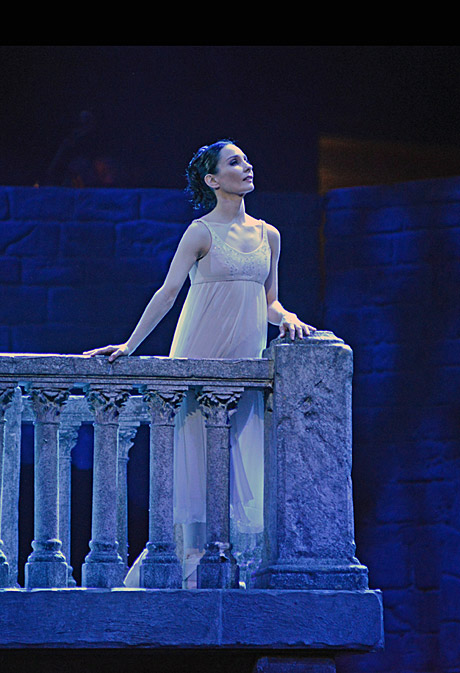
© Dave Morgan. (Click image for larger version)
You also cannot assume that everyone dances for the same reasons either. That was a big lesson for me. I guess I am quite a romantic in the way that I always dance because that’s all I wanted to do. And I didn’t care about the money and I didn’t care about the fame and I didn’t care about anything – I just wanted to dance and I wanted to dance the work of certain people and with certain people. And to achieve that it meant I had to be successful enough to be able to choose. So the fame was like a side thing that you had to deal with to be in a position to say that I want to work with him, and with him and with her and with her and with this and with that… but not everybody is the same. Different people have different motivations {and you have to understand that in managing} Yes. Managing people is always the most complicated thing.
A little diversion – Rojo and the World Ballet Festival
Did I hear that you are dancing at the World Ballet Festival in Tokyo this summer?
I’m going again to the World Ballet Festival {Oh fantastic!} and I’m dancing with Alban Lendorf.
I’ve always wanted to go and they are so rare, only happening every 3 years
You should – it’s extraordinary, it’s amazing. I just wish it was like the Olympics and it had to be in a different place every year. Japan one year and then London another year. That would be amazing. Sadler’s Wells could do that maybe. {You will have to talk to Alastair Spalding!} I might suggest it. Let’s do a World Ballet Festival and I’ll curate it!
{Yes – seriously!} And so many people can’t get to Japan. So if every other year it was in London…
{very expensive I hear} Yes – it is very expensive. I don’t think we could do that here – I mean no-one would pay $1000 for one ticket…
How much longer will Rojo dance?
How much longer do you think you can do this dual role of being such a wonderful dancer and being a director?
Not much longer. I do think it was the right thing for this organisation. I’ve actually always been incredibly excited by companies when they have had dancing directors – so Festival Ballet and Peter Schaufuss, American Ballet Theatre and Misha (Mikhail) Baryshnikov, Nureyev and Paris Opera Ballet. I don’t know what it is, but there is an energy and something changes in those organisations. So I thought that was the right thing for ENB, at this particular time. But obviously it depends how long I stay here, but if I stay for the decade that I hope I do {I hope you do} then obviously that won’t continue – for much longer.

Do you look at it a year at a time?
Yes. I look at everything much further ahead, since being a director I have to look at things 3 years ahead, 5 years ahead and 10 years ahead. So when we talk to venues, very often it’s 10 years ahead. And when we talk about new productions it’s 3 years ahead. So I now look at things much further than I did as a dancer. But as a dancer, as a person, to be honest I’m even less than a year. I’m looking at “OK can I stay and do this, what does my body tell me”. I’m much more relaxed (about it) – it’s beautiful to dance and it still brings me a lot of joy. And I’m really happy that now I’m dancing this amazing repertoire, that I always wanted to dance {she chuckles}, and working with creative people that I always wanted to work with. So that’s really good. And I do believe I’m still a good dancer – I do my best. {of course you’ve still got it – big time} Thank you. But yes, I think it wouldn’t be as heartbreaking if tomorrow someone said “You’re done” – then I would be like, wooo, you know that it was quite a good ride. {we both laugh – and I go Yeah!} I think I can look at myself in the mirror and really honestly say “You did your best.”









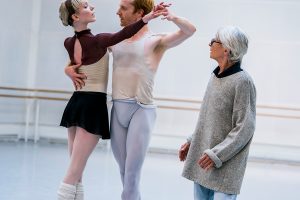


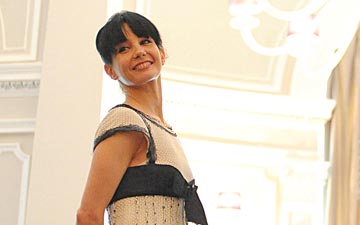

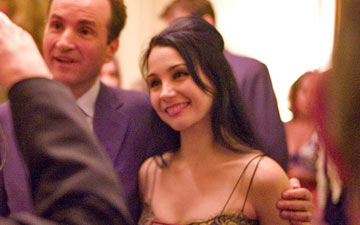


Wonderful to read such an in depth interview with Tamara. She’s an amazing advocate for dance and supporter of dance artists. Even with the pressure of running ENB she has remained a very active Board member of Dance UK.
She’s just donated the chance for two people to have a private dinner with her at the beautiful Spanish restaurant Hispania, to help raise funds to support Dance dancers, choreographers and dancers’ health through Dance UK’s work. Anyone can bid online at http://www.sdhightea-auction.com/lite-ui/#lots/show/1